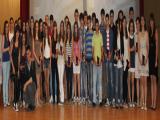Headlines and events archive
Displaying 701 - 750 of 1543
You may also find an archive of news published in the media which are related with the Instituto de Astrofísica de Andalucía - CSIC.
Pages

|
14/06/2012 - 14:00
Holographic imaging of dense fields: the amazing poor man's MCAO Being able to image large fields at the diffraction limit of large telescopes is one of Astronomy's oldest dreams. The standard way toward achieving this goal is to throw lots of money at it and build ever more sophisticated adaptive optics (AO) systems. As an alternative way, I present an algorithm for speckle holography that has been optimised for diffraction limited imaging of crowded fields. I will present the exciting... Rainer Schoedel |

|
31/05/2012 - 14:00
NITROGEN-TO-OXYGEN RATIO AS A SOLID TOOL TO ASCERTAIN THE CHEMICAL EVOLUTION OF STAR-FORMING GALAXIES Nitrogen is one of the most abundant metals in the ISM and thus emitting strong emission-lines in the optical spectrum of ionized gaseous nebulae. Its nucleosynthetic origin is quite different to that of oxygen as it is produced both by massive stars and by intermediate- and low-mass stars. Thus, the study of the nitrogen-to -oxygen ratio by means of especially defined strong-line methods offers a powerful tool to inspect with... Enrique Pérez Montero |

|
26/05/2012 - 15:00
Testeado de Posicionadores de Fibras Ópticas y Desarrollo de Interfaz de Comunicación para Instrumentos de Próxima Generación El Robot comercial de montaje Kawasaki, se baraja como posible brazo posicionador de fibras ópticas para del instrumento OPTIMOS-EVE (E-ELT). La Universidad de Oxford forma parte del consorcio de los espectrógrafos OPTIMOS-EVE y WEAVE (WHT, ambos con elementos retractores de fibras de similar diseño. Como parte de mi proyector fin de máster establecí las bases técnicas para la realización de las... Zaira Modroño Berdiñas Sala de Juntas del Nuevo Edificio (IAA-CSIC) |

|
24/05/2012 - 14:00
Development of a miniaturized real time attitude controller for micro and nanosatellites In last years low cost space missions have become an instrument for many research institutes to test new technologies and perform low-orbit Earth science using commercial components. Cubesat represent the most popular standard for microsatellites, but due to low cost components and reduced size, there are no complete attitude controllers available for the smallest versions. This talk will describe the development of a control system... Gian Paolo Candini |

|
18/05/2012
PIIISA 2012 - Young people and Science The PIIISA 2012 project ended yesterday. A project that aims to join high school students with the professional investigators. |

|
17/05/2012 - 14:00
Ice Rocks in the Solar System The study of the minor bodies in the Solar System has historically been a major source of information. The term "Minor Body" covers objects exhibiting very different dynamical and compositional characteristics, in fact, every object in the Solar System that is not a planet or a star, is a minor body. All these objects share a common link, they were the building blocks of the Solar System that we observe today and are considered to... Noemi Pinilla Alonso |

|
10/05/2012 - 14:00
The thirteen billion year history of the most massive black holes Super-massive black holes (BHs) that are found in the centers of most galaxies started their growth when the universe was about 300 million years old. Some of these "seed black holes" were probably the remnants of the earliest stars. The largest BHs, that are some 10^10 times more massive than the sun, accumulated most of their mass during the first 3 billion years after the big bang. The less massive ones are still growing today. I... Hagai Netzer |

|
03/05/2012 - 13:00
Detecting substructure in the galactic stellar halo with Gaia We present a Gaia mock catalogue we have created to test various approaches to detect the presence of past mergers in the Galactic halo. We propose an extension of the great circle cell method of Johnston et al. (1996), which is optimized to identify tidal debris along great circles in the sky. We have added the proper motion information that will be supplied by Gaia to add a kinematical restriction to the original method. We test our... Luis A. Aguilar |

|
26/04/2012 - 14:00
The Hubble Space Telescope's Wide Field Camera 3 The Wide Field Camera 3 (WFC3) was installed in 2009 and is now the primary science instrument on HST. Under development since 1998, WFC3 expanded Hubble's ultraviolet and infrared imaging capabilities by factors of more than 20. WFC3 also provides an unparalleled capability for low resolution infrared spectroscopy of very faint sources. This talk will discuss the scientific goals for WFC3, its basic design and technological... John Mackenty |

|
25/04/2012 - 15:00
The Virtual Observatory: The e-Science Environment for Discovery & Collaboration in Astrophysics La astronomía nace cuando el hombre comienza a registrar en diversos medios (tablillas de piedra, papiros, dibujos, fotografías, y recientemente en forma digital) lo que observa en el cielo. En esta charla veremos cómo la cantidad de información accesible a los astrónomos está creciendo de forma exponencial, mientras que su capacidad de procesamiento se está estancando, y que la solución... Juande Santander Vela Sala de Juntas del Nuevo Edificio (IAA-CSIC) |

|
18/04/2012
Over a hundred researchers meet in Granada to discuss the future of the study of galaxies The workshop, taking place from today until Friday,will delve into a technique that is proving in the study of galaxy evolution,integral field spectroscopy. |

|
12/04/2012 - 14:00
Oxygen in the Universe: a historic introduction We briefly review the main steps that led to the discovery of oxygen in the Universe and to the understanding of its production and cosmic evolution. We highlight some of the problems that still need an explanation. Grażyna Stasińska |

|
28/03/2012 - 15:00
Jet wobbling en jets relativistas: el caso del blázar NRAO150 Los jets están presentes en numerosos escenarios astrofísicos. En particular los jets en galaxias con núcleos activos (AGN) son de las fuentes de radiación mas intensas del universo y presentan estructuras observables a longitud de onda de radio que van desde unos pocos parsec a cientos de Kpc. En los últimos años se ha observado en un mayor número de blázares un cambio en la direcci... Sol Natalia Molina Sala de Juntas del Nuevo Edificio (IAA-CSIC) |

|
28/03/2012 - 14:00
A new golden age in Spanish Astronomy: the GTC Spanish Astronomy has experienced a great development during the last 20-30 years, which can be, in part, associated to the available technological resources. Extragalactic astronomy started in Spain due to the agreement for the development of the Observatory of the Roque de los Muchachos, with the installation of the INT 2.5m and WHT 4.2m telescopes and their associated instrumentation. Of course the CAHA... Josefa Masegosa |

|
15/03/2012 - 13:00
What can we learn from gamma-ray anisotropies? Over the last two decades the study of angular anisotropies provided a huge amount of information, when used to analyze the Cosmic Microwave Radiation. The same approach can be extended also to higher energies, studying angular fluctuations in the gamma-ray emission. In this talk I will refer in particular to the data of the Fermi-LAT telescope that has recently presented its measurement of the angular power spectrum (APS) of anisotropies at... Mattia Fornasa |

|
05/03/2012 - 16:00
LINERs, ¿Son también AGNs? Los LINERs (Low Ionization Narrow Emission-line Regions) representan la población más abundante de los AGNs en el Universo local. Se trata de AGNs de baja luminosidad, que podrían resultar ser el nexo de unión entre las galaxias normales y las activas. Haremos un recorrido por las características que muestran los LINERs, tratando de introducirlos en el modelo unificado de AGNs. Lorena Hernández García Sala de Juntas del Instituto de Astrofísica de Andalucía (IAA-CSIC) |

|
05/03/2012 - 13:00
MIRADAS: The Next-Generation Infrared Spectrograph for the GTC MIRADAS is a near-infrared multi-object R=20,000 echelle spectrograph for the 10.4-meter Gran Telescopio Canarias. It is the most powerful astronomical instrument of its kind ever envisioned, with an observing efficiency more than an order of magnitude greater than current capabilities for 10-meter-class telescopes. The (still-growing) MIRADAS science team includes more than 40 scientists from 8 institutions in the GTC community. In this talk... Stephen Eikenberry |

|
23/02/2012 - 13:00
Seeking and Mocking Non-thermal Emission in Galaxy Clusters Diffuse synchrotron radio emission is observed in many clusters of galaxies probing the presence of high energy cosmic ray (CR) electrons. This emission can be explained by the hadronic model where the electron population originates from the interactions between CR protons and the cluster ambient gas. Additionally, a very high energy gamma-ray emission is also expected. I will briefly review the current knowledge on the non-thermal emission... Fabio Zandanel |

|
20/02/2012
HEXA: the future of sky mapping Today begins a meeting about HEXA, a project for a new 6,5 meter telescope to be located at Calar Alto Observatory (Almería) |

|
16/02/2012 - 13:00
Modelos teóricos de las nebulosas de Eta Carinae En esta plática se presentan modelos teóricos de los eventos eruptivos de 1840 (la gran erupción) y de 1890 (la menor erupción) de la estrella masiva Eta Car. Las nebulosas bipolares en torno a la estrella se formaron de la interacción del material eyectado durante estas erupciones con el viento estándar de la estrella. En nuestros modelos, se supone un escenario de colisión de... Ricardo Francisco González Domínguez |

|
09/02/2012 - 16:00
Supernovas. Dónde, cuándo y por qué Las explosiones de supernova se encuentran entre los fenómenos más violentos del Universo y la enorme energía que se libera en ellas hace que podamos observarlas a grandes distancias. Estudiando el lugar y la velocidad a la que se producen, podemos obtener información física fundamental de las galaxias en las que ocurren. En concreto, veremos cómo la distribución radial de supernovas a lo largo... Rubén Herrero Illana Sala de Juntas del Instituto de Astrofísica de Andalucía (IAA-CSIC) |

|
02/02/2012 - 13:00
Efectos de los cúmulos ionizantes de baja masa en el espectro de regiones HII y galaxias En este seminario presentaré mi trabajo de tesis sobre el modelado del espectro de líneas de emisión de regiones H II y galaxias con formación estelar. Primero hablaré sobre la influencia de los efectos de muestreo de la función inicial de masas estelares (IMF) en el continuo ionizante de los cúmulos y en el espectro de regiones H II, centrando la atención en los cú... Marcos Villaverde |

|
26/01/2012 - 13:00
Maser emission in evolved stars: from AGB to PNe I will present a review of maser emission in evolved stars from the asymptotic giant branch (AGB) to planetary nebulae (PNe). The circumstellar envelopes of oxygen-rich evolved stars provide optimal conditions to pump different species of masers, emitting at radio wavelengths. Interferometric observations of masers are a powerful tool to study with the highest angular resolution the molecular gas around evolved stars, because... Lucero Uscanga Aguilera |

|
19/01/2012 - 13:00
Dwarf galaxies as dark matter laboratories Dwarf spheroidal galaxies are key objects in the current cosmological paradigm: first, they are the least luminous galaxies, likely signaling the minimum halo mass at which gas can be accreted and converted into stars. Second, they all have ancient stellar populations, providing clues on star formation/feedback processes at early stages of the Universe. Third, they are the most numerous satellites about the Milky Way and M31,... Jorge Peñarrubia |

|
17/01/2012 - 13:30
Albedo and atmospheric constraints of dwarf planet Makemake from a stellar occultation Makemake is an icy dwarf planet with a spectrum similar to Eris and Pluto, and is currently at a distance to the Sun intermediate between the two. Although Makemake’s size (1,420 ± 60 km) and albedo are roughly known, there has been no constraint on its density and there were expectations that it could have a Pluto-like atmosphere. Here we report the results from a stellar occultation by Makemake on 2011... José Luis Ortiz |

|
12/01/2012 - 13:00
Everything you always wanted to know about extinction but were afraid to ask Twenty two years ago Cardelli et al. published their seminal paper on Galactic extinction laws. In the first part of my talk I will explore that (often quoted but also often misunderstood) paper and detail its strengths and weaknesses. In the second part I will describe the two datasets that have finally allowed the Cardelli et al. laws to be tested to their limit and I will present a new family of extinction laws derived from the new data... Jesús Maíz Apellániz |

|
11/01/2012 - 16:00
Profundidad de falla y flujo térmico en Mercurio Los escarpes lobulados son las estructuras tectónicas más relevantes existentes en Mercurio. Su morfología y la deformación producida en su intersección con otras estructuras indican que los escarpes constituyen la expresión en superficie de fallas inversas formadas, principalmente, por el enfriamiento y contracción del planeta. A partir de la geometría de estas fallas podemos obtener... Mª Isabel Egea González Sala de Juntas del Instituto de Astrofísica de Andalucía (IAA-CSIC) |

|
10/01/2012 - 13:30
IAA: its structure, failures, and potential In this talk I will first show the structure of our Institute, the task division and the people responsible for these taks. I will also analyse all the procedures, customs and usages that drift us apart from the dream IAA. Finally, I will make some remarks about the (underestimated? disregarded?) potential of our Institute. Matilde Fernández Hernández |

|
22/12/2011 - 12:34
Dynamical Modeling of Luminous Infrared Galaxy Mergers It is widely accepted that galaxy mergers can have a significant effect on galaxy properties and may be an important part of galaxy evolution. Enhanced star formation is one frequently observed property of (gas rich) mergers and theoretical prescriptions for star formation can generally reproduce the observed behavior. However a detailed study comparison of these prescriptions with individual galaxy merger events has not been... George C. Privon |

|
15/12/2011 - 13:00
X-ray properties of nearby luminous infrared galaxies I present results of X-ray observations of a complete sample of luminous infrared galaxies (LIRGs) from the GOALS, a multi-wavelength project to study the most luminous IR-selected galaxies in the local Universe. X-ray imaging at an arc-second resolution obtained with the Chandra X-ray Observatory provides locations of an active nucleus, if present, and extended morphology of starburst-driven winds in those LIRGs. An inspection of their X-ray... Kazushi Iwasawa |

|
01/12/2011 - 13:00
Mass, metallicity and SFR relationships in star forming galaxies using deep surveys To understand the formation and evolution of galaxies, it is important to have a full comprehension of the role played by Metallicity, Star Formation Rate (SFR), and stellar mass of galaxies. The interplay of these parameters at different redshifts will substantially affect the evolution of galaxies and, as a consequence, the evolution of these parameters provides important constraints for the galaxy evolution models. We studied the... Maritza A. Lara-Lopez |

|
24/11/2011 - 13:00
The Bayesian Galaxy Cluster Finder and its Application to Large Surveys One of the main purposes of Large Surveys is the study of galaxy clusters. However, it is not an easy task to compile a complete sample. In this talk, I will present a new technique for detecting galaxy clusters called the Bayesian Cluster Finder (BCF) which is able to determine the position, redshift and richness of clusters in any survey. I will introduce the simulations that we performed to test the algorithm through realistic mock galaxy... Begoña Ascaso |

|
23/11/2011 - 16:00
Vientos Estelares en Estrellas Masivas En esta charla se dará una perspectiva general sobre los vientos en estrellas masivas. En particular se pretende explicar la emisión de rayos X alrededor de estrellas masivas evolucionadas. Jesús Alberto Toalá Sala de Juntas del Instituto de Astrofísica de Andalucía (IAA-CSIC) |

|
17/11/2011 - 13:00
Revealing the hidden supernova population in luminous infrared galaxies A substantial fraction of star formation (SF) and hence of the core-collapse supernovae (CCSNe) in the Universe is hidden behind dust. At higher-z obscured star formation in luminous and ultraluminous infrared galaxies (LIRGs and ULIRGs) actually dominates over SF seen in the UV and optical. These same objects are expected to hide in their nuclear regions large numbers of undetected CCSNe. In this talk I describe our ongoing efforts using... Seppo Mattila |

|
07/11/2011
Science Week at IAA Fifht edition of Noches de Ciencia, a series of conferences for the Science Week |

|
03/11/2011 - 13:00
Gamma-Ray-Bursts, High-Energy-Cosmic-Rays and Beam-Plasma Instabilities Gamma-Ray-Bursts and High-Energy-Cosmic-Rays are two of the most intriguing enigmas of astrophysics. A promising scenario solving both problems consists in the Fermi-like acceleration of particles by relativistic collisionless shocks. These shocks could generate the Gamma Burst together with some highly energetic cosmic rays, in the earlier phase of a Supernovae explosion. Later on, the Supernovae Remnant could still accelerate cosmic... Antoine Bret |

|
02/11/2011 - 16:00
El zoológico de los plasmas en la alta atmósfera En verano de 1989 investigadores estadounidenses grabaron varios fotogramas de intensos destellos luminosos provenientes de un fragmento de cielo, sin nubes localizado a más de 50 km de altura y que, sin que ellos se dieran cuenta en ese momento, se encontraban sobre lejanas nubes de tormenta. Habían hecho la primera observación de los llamados Transient Luminous Events o TLEs. Francisco Carlos Parra Rojas Sala de Juntas del Instituto de Astrofísica de Andalucía (IAA-CSIC) |

|
27/10/2011 - 14:00
Locating the gamma-ray emission region in AGN from multi-messenger observations Relativistic jets in AGN, in general, and in blazars, in particular, are among the most energetic and powerful astrophysical phenomena known so far. Their relativistic nature provides them with the ability to emit profusely at all spectral ranges from radio wavelengths to gamma-rays. They display extreme variability at all time scales (from hours to years). Since the birth of gamma-ray astronomy, locating the origin of gamma-ray emission has... Iván Agudo |

|
20/10/2011 - 14:00
Mapping star-formation in the Milky Way In the last few years, it has become possible to measure the distance and the velocity vector of young stars located within 500 pc of the Sun with an accuracy of order 1% using Very Long Baseline Interferometry (VLBI) techniques. This represents an improvement by more than 1 order of magnitude over what was previously possible, and opens the door to some extremely high accuracy astrophysics. In particular, theoretical pre-main sequence... Laurent Loinard |

|
06/10/2011 - 15:00
Estallidos de rayos gamma: una breve introducción Los Estallidos de Rayos Gamma son los eventos más energéticos en el Universo después del Big Bang. Ocurren a distancias cosmológicas, con desplazamientos al rojo conocidos de hasta z=8.2. Son fenómenos de sumo interés para diversas áreas de la Astronomía y la Física de Altas Energías. Dada la falta de transparencia de nuestra atmósfera a los rayos gamma y la corta... Juan Carlos Tello Sala de Juntas del Instituto de Astrofísica de Andalucía (IAA-CSIC) |

|
22/09/2011 - 14:00
Early r-process enrichment in the halo: Process and implications/The future role of the Nordic Optical Telescope I: Early r-process enrichment in the halo: Process and implications Current thinking suggests that the outer Galactic halo formed first, with stars dominated by fresh C(NO) elements, but soon with increasing amounts of heavier elements. The now appreciable sample of extremely metal-poor (EMP) stars with [Fe/H] ~ -3 trace the transition to this chemically more diversified regime. A small fraction of these EMP giants contain r-process... Johannes Andersen |

|
16/09/2011 - 13:00
Early Planet Formation from an Experimentalist’s Point of View Planet formation starts in gaseous protoplanetary disks. Small grains move around, collide, stick together and grow. However, many collisional roads also lead to destruction of larger bodies. Which ones are prevailing and if this is the basic way to planet formation is still an open question, but there are modes to grow particles to larger size even in ‘high speed’ collisions. This talk will also touch upon processes of transport... Prof. Gerhard Wurm |

|
05/09/2011 - 09/09/2011
20th Stellar Pulsation Conference Series Granada |

|
07/07/2011 - 14:00
Coagulation, restructuring and fragmentation of dust grains in the protoplanetary disks: first stages of Solar System formation The understanding of the formation of the planetary systems is one of the main topics of modern astrophysics and its study requires a synergetic effort of observations, laboratory experiments and theoretical models. It is generally accepted that planets originate in the dust disk that remains around a star after its formation (protoplanetary disk). Nevertheless there are no clear ideas on the physical conditions that are required, neither on... Walter Sabolo |

|
30/06/2011 - 14:00
Quasi-periodicities in the periodograms of Corot Delta Scuti stars Periodic patterns are not expected to be found in the frequency spectra of delta-Scuti stars, as in solar-like pulsators. However, some efforts have been carried out in order to find any signal of periodicity in this type of stars (Handler et al., 1997; Breger et al., 1999, 2009). These works used ground-base observations and the results have not been conclusive. In our study we have used data from CoRoT of two delta-Scuti stars poorly known. We... Antonio García Hernández |

|
29/06/2011 - 15:00
El impacto de la astrosismología en astrofísica El conocimiento sobre la estructura y la física de los interiores estelares ha tenido un importante avance durante las últimas décadas gracias a la interpretación de las pulsaciones observadas en ellas. Esa es la meta principal de la Astrosismología. No obstante, los resultados que se desprenden de las investigaciones realizadas por astrosismólogos pueden tener un gran impacto sobre distintos campos de... Javier Pascual Granado Sala de Juntas del Instituto de Astrofísica de Andalucía (IAA-CSIC) |

|
20/06/2011 - 14:00
Simulation of Relativistic Jets with Macroscopic and Microscopic Processes and Associated Self-consistent Radiation Relativistic jets are ubiquitous in astrophysical systems. In this talk I will present recent research results from RMHD simulations designed to study the CD kink instability of relativistic jets and the magnetic field amplification that occurs in relativistic shocks in an inhomogeneous medium. I will then present the results of RPIC simulations of particle acceleration in relativistic shocks and self-consistent calculation of the radiation at... Ken Nishikawa |

|
16/06/2011 - 14:00
Time-Dependent Hamiltonians in Quantum Mechanics and Inflationary Cosmology We revise the problem which appears in Quantum Mechanics when the Hamiltonian depends explicitly on time and provide a general setting to address such quantum systems. As a paradigmatic example we analyse the case of the damped harmonic oscillator (satisfying the Caldirola-Kanai equation) and extend the system to accomodate the ordinary time translation as a true symmetry (Bateman dual system). This general scheme applies in particular to the... Julio Guerrero García |

|
08/06/2011 - 15:00
Método K-Correlated para el estudio del transporte radiativo en Marte En esta sesión CCD os explicaré en que consiste el método k-correlated, técnica usada para el estudio del transporte radiativo. Hablaré sobre sus ventajas e inconvenientes y expondré algunos de los últimos resultados que hemos obtenido. Javier Ruiz Madrona Sala de Juntas del Instituto de Astrofísica de Andalucía (IAA-CSIC) |

|
07/06/2011 - 14:00
EST: a large solar telescope for the XXI century The European Solar Telescope (EST) is a project for a 4-meter class telescope to be located in the Canary Islands. It is promoted by the European Association for Solar Telescopes (EAST). This is a consortium formed by a number of research organizations from fifteen European countries (Austria, Croatia, Czech Republic, France, Germany, Hungary, Italy, the Netherlands, Norway, Poland, Slovak Republic, Spain, Sweden, Switzerland, and United... Manolo Collados |